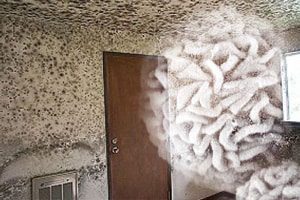
Superstorm Sandy continues to wreak havoc up and down the Eastern seaboard, one month after the massive hurricane struck. “There are asbestos roofs that have collapsed near the ocean,” roofer, Ken Court, told NBC News from atop his father’s Breezy Point, New York home. “There is a lot of dust. You see people walking around […]
 Superstorm Sandy continues to wreak havoc up and down the Eastern seaboard, one month after the massive hurricane struck.
Superstorm Sandy continues to wreak havoc up and down the Eastern seaboard, one month after the massive hurricane struck.
“There are asbestos roofs that have collapsed near the ocean,” roofer, Ken Court, told NBC News from atop his father’s Breezy Point, New York home. “There is a lot of dust. You see people walking around with masks on. You use the hand cleaners all day long.” Much of Breezy Point was decimated during Sandy when a six-alarm fire destroyed blocks of homes. One month after the historic storm, Breezy Point remains with no power, no clean water, and no idea when either will be restored, said NBCNews.
Sandy made landfall on October 29 in southern New Jersey and northern Delaware as a Category 1 hurricane, a part of the country not normally affected by direct hurricane landfalls. Even before Sandy made landfall, its torrential rains and strong winds combined to create record storm surges that helped batter the coastline initially, knocking out electricity for millions. The storm eventually “morphed” into a Nor’easter, which locals are more accustomed to occurring on an almost annual basis, but not to the scale of this storm, hence earning the name Superstorm Sandy.
Billions of dollars in property damage has already been recorded and that number will likely increase. Long Island and Manhattan sustained severe damage from strong winds, heavy rains, and storm surges.
Court notes that long-term problems are looming. “You should really wear masks. I remember that everyone in 9/11, when they went there to help, they got sick,” Court told NBCNews in a telephone interview. In addition to asbestos, numerous chemicals were released as a result of the World Trade Center collapse, leaving a huge dust cloud that lingered over lower Manhattan. In fact, noted NBCNews, firefighters, police, and other rescue workers are now eligible for federal compensation for illnesses—including some 50 different types of cancer—they developed due to their work at the site.
“Those corrugated roofs on the houses down by the ocean—they’re all asbestos,” Court pointed out. The New York City Department of Health and Mental Hygiene states on its web site that “While Sandy has not caused problems with outdoor air quality, indoor dust, mold, fumes from temporary heating sources and the use of strong cleaning products can be irritating to the eyes, throat, and lungs. Dust can also be produced by repair and debris removal. In addition, debris removal and repair work can lead to injuries of various types.”
Mold is a significant concern and health officials say that anything that might become moldy should be removed or thoroughly cleaned with a solution containing bleach. NBCNews noted that mold spores can lead to allergic reactions or asthma in some people.
For the most part, Manhattan’s water system remained in tact; however, Breezy Point’s water pipes were seriously damaged and the water there is not safe to drink, said NBCNews. “DO NOT drink the water from the faucets. Do not use this water to cook, wash yourself or wash food, make ice, brush teeth or for any other activity involving consumption of water,” the Breezy Point Cooperative web site advises. NBCNews notes the water is not safe after boiling, which means chemical contamination might have occurred.
“With the hurricane there was this enormous flood of water that came into the city and flooded sewage treatment plants and also damaged pipes,” Andrew Juhl, an ecologist and oceanographer at Columbia University, told NBCNews. “It is possible that there was a lot of sewage released. We don’t really know. No one was out sampling at that time.” Juhl’s tests, conducted just after Sandy hit, revealed a lot of bacteria brewing in the water, People should not touch the water without washing up afterwards, said NBCNews.
Juhl’s team took samples from flooded basements in Queens, New York—the water there was rampant with bacteria typically seen in sewage. Dried out debris left by the storm also was full of germs, said NBC News. “The stuff we sampled up in Rockland County had been sitting around dry for a week and it still had really high (bacterial) counts. That actually surprised me,” Juhl said. People “should wear gloves. They should wear facemasks. They should make sure they clean themselves really well before they eat. We don’t know what the specific threat is. I would be prudent,” Juhl told NBCNews. “Most people are wearing protective equipment when they are working in the basements,” Court said. “You wear boots.”


